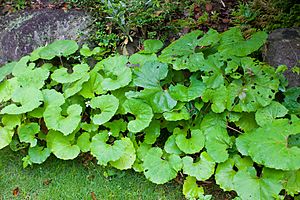Giant butterbur facts for kids
Quick facts for kids Giant butterbur |
|
|---|---|
 |
|
| Adult fuki | |
 |
|
| Fuki shoot | |
| Scientific classification | |
| Genus: |
Petasites
|
| Species: |
japonicus
|
| Nutritional value per 100 g (3.5 oz) | |
|---|---|
| Energy | 59 kJ (14 kcal) |
|
3.61 g
|
|
|
0.04 g
|
|
|
Protein
|
0.39 g
|
| Vitamins | Quantity
%DV†
|
| Thiamine (B1) |
2%
0.02 mg |
| Riboflavin (B2) |
2%
0.02 mg |
| Niacin (B3) |
1%
0.2 mg |
| Pantothenic acid (B5) |
1%
0.032 mg |
| Vitamin B6 |
7%
0.096 mg |
| Folate (B9) |
3%
10 μg |
| Vitamin C |
38%
31.5 mg |
| Minerals | Quantity
%DV†
|
| Calcium |
10%
103 mg |
| Iron |
1%
0.1 mg |
| Magnesium |
4%
13 mg |
| Manganese |
13%
0.274 mg |
| Phosphorus |
2%
12 mg |
| Potassium |
22%
655 mg |
| Sodium |
0%
7 mg |
| Zinc |
2%
0.16 mg |
|
Link to USDA Database entry
|
|
| †Percentages estimated using US recommendations for adults. | |
The Giant Butterbur, also known as fuki or sweet-coltsfoot, is a very large plant. It is a perennial plant, which means it grows back every year. This plant belongs to the Asteraceae family, which also includes daisies and sunflowers.
You can find Giant Butterbur growing naturally in countries like China, Japan, and Korea. It was also brought to other places, including parts of Europe and North America. For example, Japanese people brought it to southern British Columbia in Canada.
This plant is usually dioecious. This means that male and female flowers grow on separate plants. Sometimes, you might find flowers that look like both, but they usually cannot produce seeds.
Contents
How People Use Giant Butterbur
People have used Giant Butterbur as a vegetable for a long time. It is especially popular in Japanese and Korean cooking. The young shoots are the part that is usually eaten.
Preparing Fuki for Cooking
Before cooking, fuki needs special preparation. This helps remove a bitter taste. People traditionally soak the shoots in water after treating them with ash or baking soda. This method is called aku-nuki in Japanese, which means "harshness removal."
Delicious Dishes with Fuki
Once prepared, fuki can be used in many tasty ways. In Japan, the shoots are often chopped and stir-fried with miso paste. This creates a dish called fuki-miso. People enjoy fuki-miso spread thinly over hot rice.
The young, bulb-like shoots can also be picked fresh. They are often fried as tempura, which is a popular Japanese dish. In Korea, fuki is steamed or boiled. After cooking, it is pressed to remove extra water. Then, sesame oil or perilla oil is added to make a dish called namul.
Safety When Eating Fuki
Like some other plants in its family, fuki contains natural compounds called pyrrolizidine alkaloids. These compounds can be harmful to the liver if eaten in large amounts or without proper preparation. One specific compound found in fuki is called petasitenine.
However, traditional cooking methods are very important for safety. The special preparation steps, like soaking and treating the plant, help to greatly reduce the amount of these compounds. This makes the fuki safe to eat. These traditional methods likely developed over time to remove the bitter taste and make the plant safe.
Folklore and Myths About Fuki
Giant Butterbur also plays a role in the stories and myths of the Ainu people. The Ainu are an Indigenous group from northern Japan. They tell stories about the Korpokkur, who were the first people to live in the land of Ezo (now Hokkaido).
The name Korpokkur can mean "people who dwelt below ground." It can also be understood as "people beneath the fuki." Because of this, the Korpokkur are often shown with fuki leaves in art and stories. Some tales describe them as tiny, fairy-like creatures. These tiny people were small enough to use the large fuki leaves as roofs for their homes or even as umbrellas!
Images for kids
See also
 In Spanish: Petasite gigante o fuki para niños
In Spanish: Petasite gigante o fuki para niños



